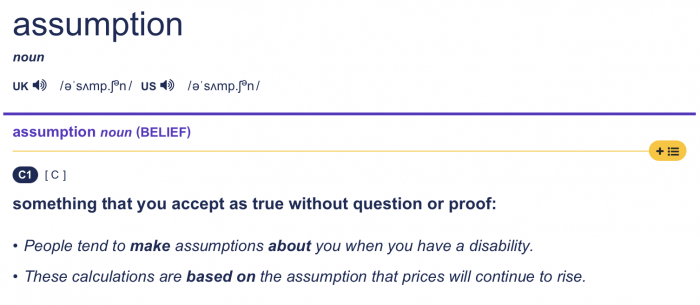The Impact of Unchecked Assumptions Part I

We’ve all been in a series of meetings where lots of points are discussed, opinions fly fast and hot and it seems like a lot is getting done – but when it all wraps up, the strategies are half-baked, the decisions are questionable, and nobody really feels good about the whole process. Though there can be many reasons for this, many times it can be traced back to unchecked assumptions among team members. In this 2-part article, we’re going to take an in-depth look at managing expectations, priorities and roles to ensure that assumptions don’t choke your workflow or, in the worst case scenario, alienate the team from itself.
First of all, what exactly is an assumption? Let’s not assume we know the meaning! The Cambridge Dictionary of English defines it as:

This seems like a very good place to start in our understanding of how assumptions evolve and could potentially harm our meeting outcomes. Both of the above definitions can easily occur in meetings unless we have a clear and defined purpose, method, and structure of authority.
What are some of the most common assumptions in a meeting? Here’s a few you might recognize:
- People making statements as if they’re facts, when in reality they’re opinions
- No clarity around how much decision making authority people have, leading to individual assumptions about the weight of one’s opinion
- Use of ambiguous terminology that could lead to multiple understandings
- People taking a completely different approach to a meeting because they don’t understand its purpose, e.g. a team member acting like final decisions are being made, when it’s merely a brainstorming session
- A lack of understanding about what the question “do we have a consensus?” really means
- A lack of understanding about what the next steps are once we do make a decision
In an environment where assumptions go unchecked, poor decisions are made, buy-in and ultimately follow through are at risk, and trust between team members can fall apart due to resentments such as:
- Resentful that they didn’t have the decision making authority they thought they had
- Resentful that some people’s voices were heard and others were not
- Resentful that team members appear to be talking at cross-purposes
- Resentful that they don’t understand why the meeting is occurring and/or what they’re being asked to achieve
So what’s the primary reason for this? What’s the root cause? Why are assumptions made? Well, it might not surprise you to learn that the cause is usually a lack of clarity about purpose (why we’re here) and outcomes (what we’re here to achieve). Human beings naturally crave order; if people walk into a meeting without clearly knowing its purpose or outcomes, we will fill the void for ourselves. We want things to be defined, we want them to be black and white with clear parameters. The human brain loves to organize. If there’s room to assume, the human brain will do it! So, let’s talk about how you can minimize the team from making incorrect assumptions. This involves two steps. Today we’ll look at step one.
Step 1: Pre-Meeting Tips to Minimize Assumptions
Our best practice is always to send out an email at least 24-48 hrs. before a meeting, outlining the agenda and the deliverables. The agenda informs us as to why we’re there, and the deliverables tell us what we need to walk out with. A good pre-meeting email should always include:
- Logistics: Timing, Location, Date etc.
- List of participants attending
- Clarity as to the meeting’s purpose and why the meeting is to happen e.g. is this meeting:
- A brainstorming session?
- A consultative feedback session, or
- An actual decision making session?
- Clarity as to the meeting’s outcomes/deliverables: What the team needs to leave the meeting with e.g. an agreement, a team charter, a strategy, etc.
Be as specific as possible in every way: tell your team exactly what they’re going to work on, and how deep you want that work to go. I often see meeting agendas that say nothing more than ‘review of quarterly strategy’. However, when you arrive at the meeting, it’s not just a review; the team is expected to problem-solve budgetary, administrative and product-related issues necessary to improve the existing strategy. Stating expectations like these specifically in the agenda will help the team prepare for the meeting appropriately, and alleviate assumptions about what they’re expected to do. This will set the stage for a productive, friction-free meeting.
With the invite sent, it is time to think through how you will open the meeting. I can’t emphasize enough how important context setting is to ensure clarity. You should consider covering the following as you start the meeting
- The role(s) you will be playing as meeting leader:
- Facilitator: leveraging the wisdom of the group
- Presenter: introducing new ideas
- Participant: an equal to the team members present
- Definition of any ambiguous terminology e.g. what we mean by ‘consensus’, ‘risk’, etc.
- Restating the existing team’s norms (interpersonal guidelines/behavioral standards)
- Identification of any negotiable and/or non-negotiable elements of the discussion
- Clarity as to the degree of decision-making authority (if a decision is to be made) e.g. the group has full authority to make and carry out a decision versus authority to make recommendations with management making the final decision
But all this preparation is nothing without the right follow-through. In my next post we’ll discuss managing and eliminating assumptions once we step into the meeting room.
Stay tuned!
Upcoming Workshops
Let us Know
Do you have a unique meeting challenge not covered by one of our blog posts? We’re always looking for different dilemmas to discuss in our articles!